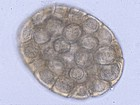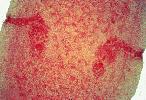Dipylidium caninum
| This article is still under construction. |
Dipylidium caninum
| Also known as: | Double-pored tapeworm
|
Introduction
D. caninum is a very commonly seen parasite of dogs and cats, growing to 50cm long in the small intestine. It is of minor clinical significance, causing no more than occasional anal irritation. Diarrhoea may result if the tapeworms are present in large numbers. The proglottids are motile and can upset owners when they drop onto the furniture or floor.
Scientific Classification
| Kingdom | Animalia |
| Phylum | Platyhelminthes |
| Class | Cestoda |
| Order | Cyclophyllidea |
| Family | Dipylidiidae |
| Genus | Dipylidium |
| Species | D. caninum |
Identification
D. caninum resemble Taenia spp, but are considerably shorter than Taenia. D. caninum have a scolex and a proglottid, which are easily recognized in this species. This parasite also has two sets of genital organs.
The eggs are 25-50μm in length.
Life-Cycle
The egg packets are likely to be dropped in the same places as the eggs of the intermediate host, the flea. When ingested by the flea larvae, the oncosphere transforms to a cysticercoid which is infective by the time that metamorphosis is complete. Flea infestation provokes exaggerated grooming behaviour and the cat or dog becomes infected with Dipylidium, when it swallows infected fleas. Prevention of re-infection therefore requires advice on flea control.

